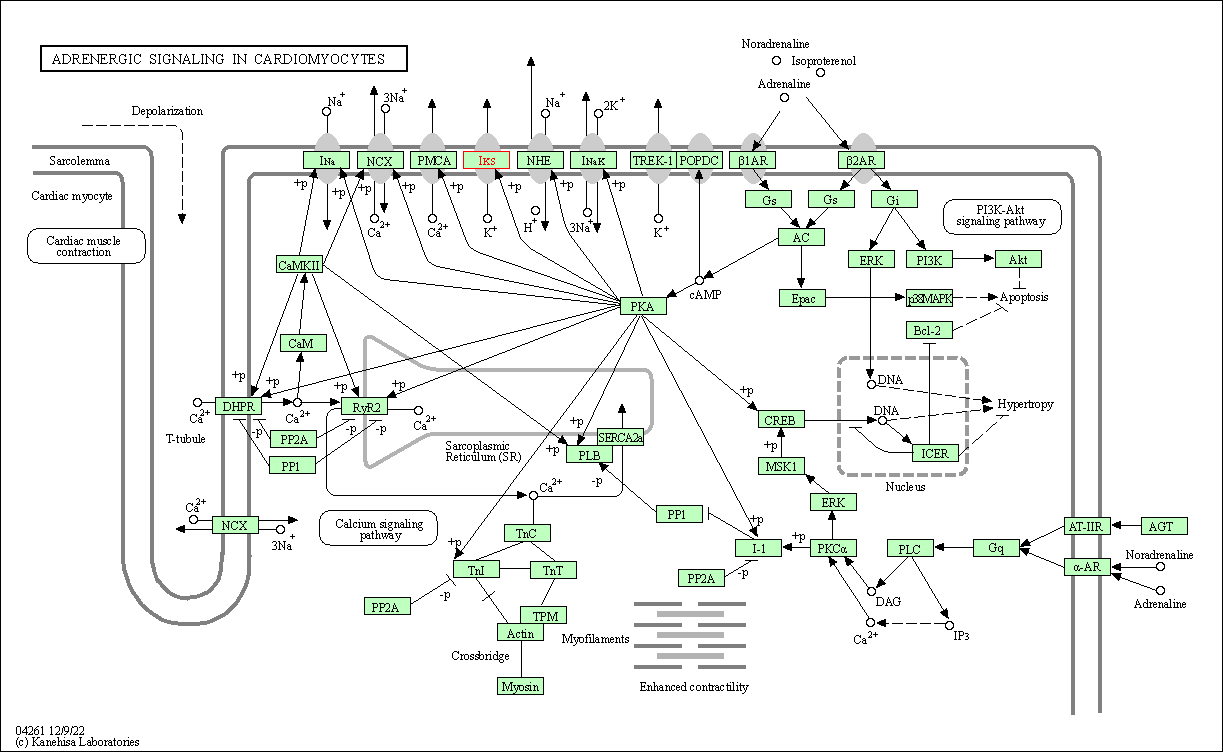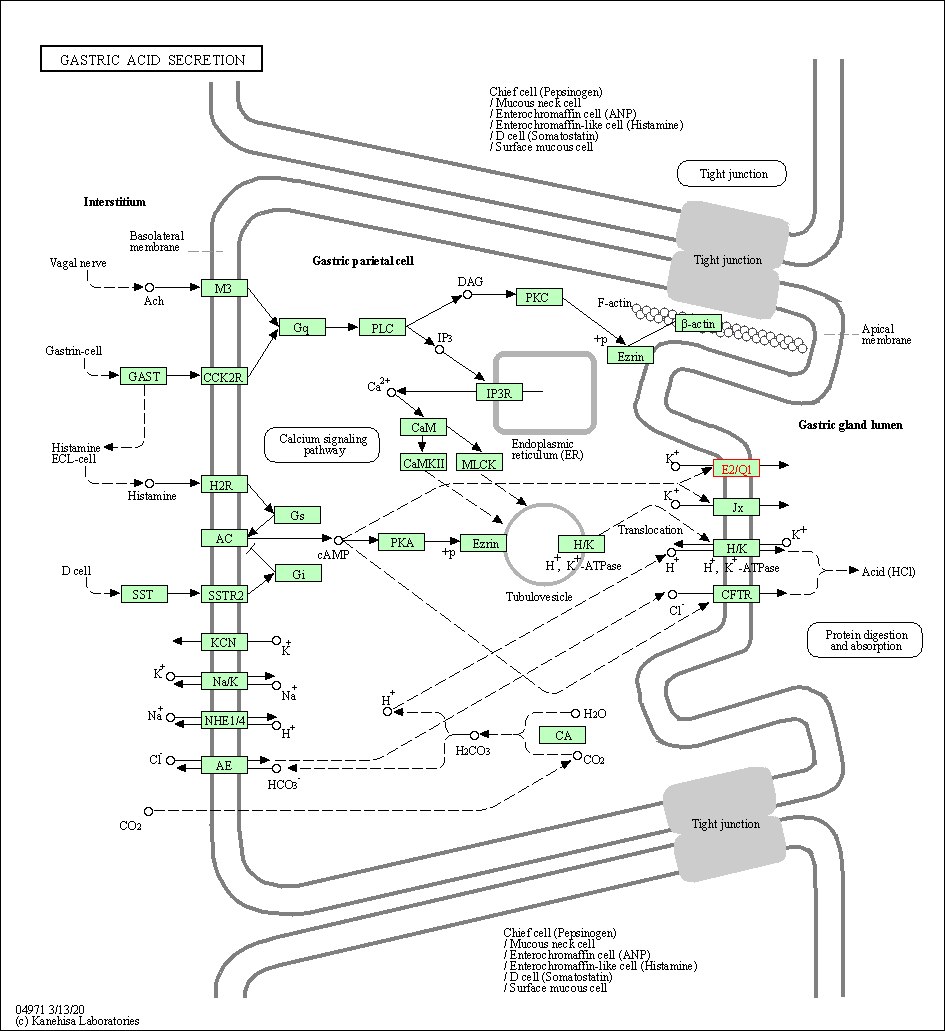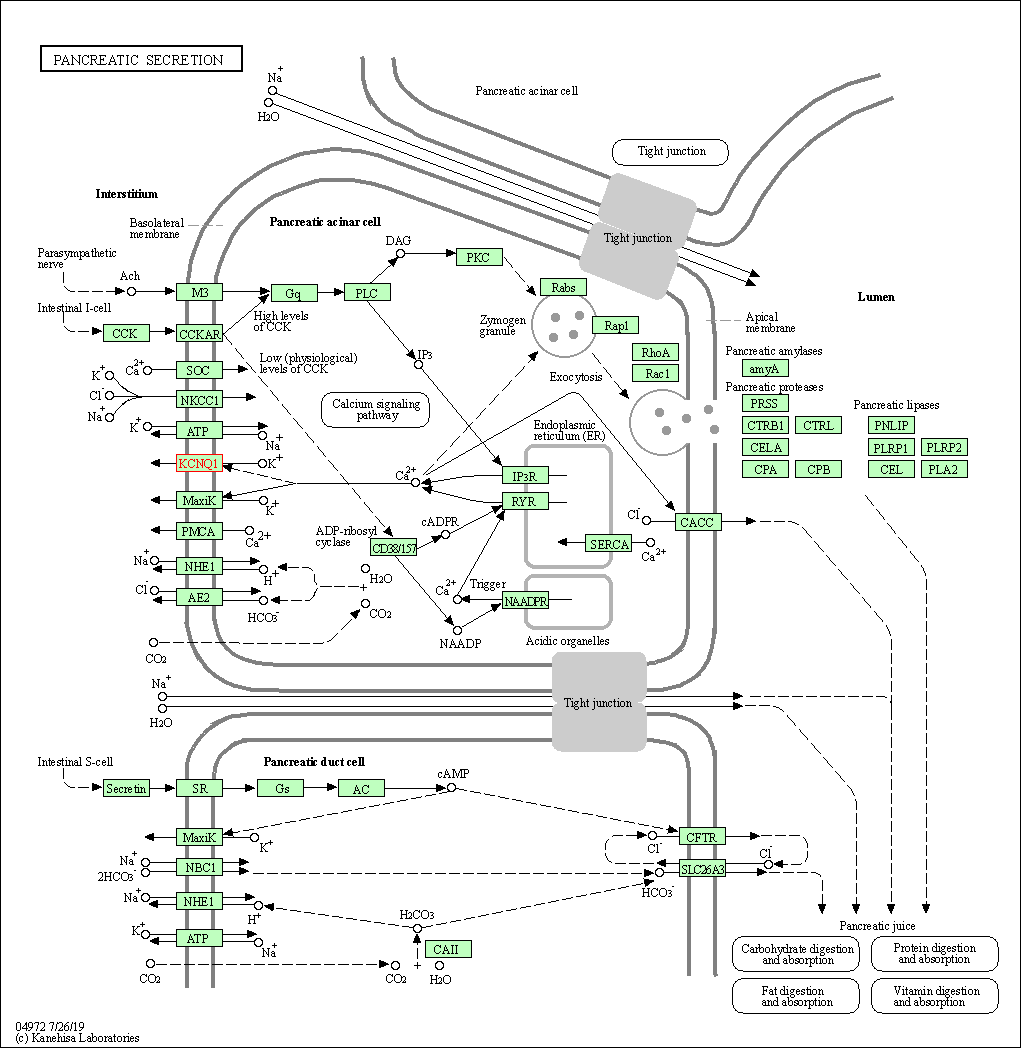Target Information
| Target General Information | Top | |||||
|---|---|---|---|---|---|---|
| Target ID |
T49526
(Former ID: TTDS00148)
|
|||||
| Target Name |
Voltage-gated potassium channel Kv7.1 (KCNQ1)
|
|||||
| Synonyms |
Voltage-gated potassium channel subunit Kv7.1; Potassium voltage-gated channel subfamily KQT member 1; Kv7.1; KVLQT1; KQT-like 1; KCNQ1 channel; KCNA9; KCNA8; IKs producing slow voltage-gated potassium channel subunit alpha KvLQT1; IKs producing slow voltage-gated potassium channel alpha subunit KvLQT1
Click to Show/Hide
|
|||||
| Gene Name |
KCNQ1
|
|||||
| Target Type |
Successful target
|
[1] | ||||
| Disease | [+] 1 Target-related Diseases | + | ||||
| 1 | Hypertension [ICD-11: BA00-BA04] | |||||
| Function |
Associates with KCNE beta subunits that modulates current kinetics. Induces a voltage-dependent by rapidly activating and slowly deactivating potassium-selective outward current. Promotes also a delayed voltage activated potassium current showing outward rectification characteristic. During beta-adrenergic receptor stimulation participates in cardiac repolarization by associating with KCNE1 to form the I(Ks) cardiac potassium current that increases the amplitude and slows down the activation kinetics of outward potassium current I(Ks). Muscarinic agonist oxotremorine-M strongly suppresses KCNQ1/KCNE1 current. When associated with KCNE3, forms the potassium channel that is important for cyclic AMP-stimulated intestinal secretion of chloride ions. This interaction with KCNE3 is reduced by 17beta-estradiol, resulting in the reduction of currents. During conditions of increased substrate load, maintains the driving force for proximal tubular and intestinal sodium ions absorption, gastric acid secretion, and cAMP-induced jejunal chloride ions secretion. Allows the provision of potassium ions to the luminal membrane of the secretory canaliculus in the resting state as well as during stimulated acid secretion. When associated with KCNE2, forms a heterooligomer complex leading to currents with an apparently instantaneous activation, a rapid deactivation process and a linear current-voltage relationship and decreases the amplitude of the outward current. When associated with KCNE4, inhibits voltage-gated potassium channel activity. When associated with KCNE5, this complex only conducts current upon strong and continued depolarization. Also forms a heterotetramer with KCNQ5; has a voltage-gated potassium channel activity. Binds with phosphatidylinositol 4,5-bisphosphate. Potassium channel that plays an important role in a number of tissues, including heart, inner ear, stomach and colon.
Click to Show/Hide
|
|||||
| BioChemical Class |
Voltage-gated ion channel
|
|||||
| UniProt ID | ||||||
| Sequence |
MAAASSPPRAERKRWGWGRLPGARRGSAGLAKKCPFSLELAEGGPAGGALYAPIAPGAPG
PAPPASPAAPAAPPVASDLGPRPPVSLDPRVSIYSTRRPVLARTHVQGRVYNFLERPTGW KCFVYHFAVFLIVLVCLIFSVLSTIEQYAALATGTLFWMEIVLVVFFGTEYVVRLWSAGC RSKYVGLWGRLRFARKPISIIDLIVVVASMVVLCVGSKGQVFATSAIRGIRFLQILRMLH VDRQGGTWRLLGSVVFIHRQELITTLYIGFLGLIFSSYFVYLAEKDAVNESGRVEFGSYA DALWWGVVTVTTIGYGDKVPQTWVGKTIASCFSVFAISFFALPAGILGSGFALKVQQKQR QKHFNRQIPAAASLIQTAWRCYAAENPDSSTWKIYIRKAPRSHTLLSPSPKPKKSVVVKK KKFKLDKDNGVTPGEKMLTVPHITCDPPEERRLDHFSVDGYDSSVRKSPTLLEVSMPHFM RTNSFAEDLDLEGETLLTPITHISQLREHHRATIKVIRRMQYFVAKKKFQQARKPYDVRD VIEQYSQGHLNLMVRIKELQRRLDQSIGKPSLFISVSEKSKDRGSNTIGARLNRVEDKVT QLDQRLALITDMLHQLLSLHGGSTPGSGGPPREGGAHITQPCGSGGSVDPELFLPSNTLP TYEQLTVPRRGPDEGS Click to Show/Hide
|
|||||
| 3D Structure | Click to Show 3D Structure of This Target | PDB | ||||
| ADReCS ID | BADD_A04352 ; BADD_A04830 | |||||
| Drugs and Modes of Action | Top | |||||
|---|---|---|---|---|---|---|
| Approved Drug(s) | [+] 1 Approved Drugs | + | ||||
| 1 | Indapamide | Drug Info | Approved | Hypertension | [2], [3] | |
| Mode of Action | [+] 4 Modes of Action | + | ||||
| Blocker | [+] 2 Blocker drugs | + | ||||
| 1 | Indapamide | Drug Info | [1] | |||
| 2 | L-735,821 | Drug Info | [8] | |||
| Inhibitor | [+] 6 Inhibitor drugs | + | ||||
| 1 | L-768673 | Drug Info | [4] | |||
| 2 | HMR-1556 | Drug Info | [6] | |||
| 3 | N-(2-Diethylamino-ethyl)-4-hexyloxy-benzamide | Drug Info | [10] | |||
| 4 | N-(3,3-Dimethyl-butyl)-4-hexyloxy-benzamide | Drug Info | [10] | |||
| 5 | N-(3,3-Dimethyl-butyl)-4-indol-1-yl-benzamide | Drug Info | [10] | |||
| 6 | N-(3,3-Dimethyl-cyclopentyl)-4-hexyloxy-benzamide | Drug Info | [10] | |||
| Blocker (channel blocker) | [+] 4 Blocker (channel blocker) drugs | + | ||||
| 1 | (3R,4S)-293B | Drug Info | [5] | |||
| 2 | 3S,4R-293B | Drug Info | [5] | |||
| 3 | IKs124 | Drug Info | [7] | |||
| 4 | XE991 | Drug Info | [12] | |||
| Activator | [+] 3 Activator drugs | + | ||||
| 1 | ML277 | Drug Info | [9] | |||
| 2 | R-L3 | Drug Info | [11] | |||
| 3 | zinc pyrithione | Drug Info | [13] | |||
| Cell-based Target Expression Variations | Top | |||||
|---|---|---|---|---|---|---|
| Cell-based Target Expression Variations | ||||||
| Drug Binding Sites of Target | Top | |||||
|---|---|---|---|---|---|---|
| Ligand Name: [(2R)-1-octadecanoyloxy-3-[oxidanyl-[(1R,2R,3S,4R,5R,6S)-2,3,6-tris(oxidanyl)-4,5-diphosphonooxy-cyclohexyl]oxy-phosphoryl]oxy-propan-2-yl] (8Z)-icosa-5,8,11,14-tetraenoate | Ligand Info | |||||
| Structure Description | structure of human KCNQ1-KCNE3-CaM complex with PIP2 | PDB:6V01 | ||||
| Method | Electron microscopy | Resolution | 3.90 Å | Mutation | No | [14] |
| PDB Sequence |
THVQGRVYNF
113 LERPTGWKCF123 VYHFAVFLIV133 LVCLIFSVLS143 TIEQYAALAT153 GTLFWMEIVL 163 VVFFGTEYVV173 RLWSAGCRSK183 YVGLWGRLRF193 ARKPISIIDL203 IVVVASMVVL 213 CVGSKSAIRG229 IRFLQILRML239 HVDRQGGTWR249 LLGSVVFIHR259 QELITTLYIG 269 FLGLIFSSYF279 VYLAEKDAVN289 ESGRVEFGSY299 ADALWWGVVT309 VTTIGYGDKV 319 PQTWVGKTIA329 SCFSVFAISF339 FALPAGILGS349 GFALKVQQKQ359 RQKHFNRQIP 369 AAASLIQTAW379 RCYAAENPLR507 EHHRATIKVI517 RRMQYFVAKK527 KFQQARKPYD 537 IEQYSQGHLN551 LMVRIKELQR561 R
|
|||||
|
|
||||||
| Click to View More Binding Site Information of This Target with Different Ligands | ||||||
| Different Human System Profiles of Target | Top |
|---|---|
|
Human Similarity Proteins
of target is determined by comparing the sequence similarity of all human proteins with the target based on BLAST. The similarity proteins for a target are defined as the proteins with E-value < 0.005 and outside the protein families of the target.
A target that has fewer human similarity proteins outside its family is commonly regarded to possess a greater capacity to avoid undesired interactions and thus increase the possibility of finding successful drugs
(Brief Bioinform, 21: 649-662, 2020).
Human Tissue Distribution
of target is determined from a proteomics study that quantified more than 12,000 genes across 32 normal human tissues. Tissue Specificity (TS) score was used to define the enrichment of target across tissues.
The distribution of targets among different tissues or organs need to be taken into consideration when assessing the target druggability, as it is generally accepted that the wider the target distribution, the greater the concern over potential adverse effects
(Nat Rev Drug Discov, 20: 64-81, 2021).
Human Pathway Affiliation
of target is determined by the life-essential pathways provided on KEGG database. The target-affiliated pathways were defined based on the following two criteria (a) the pathways of the studied target should be life-essential for both healthy individuals and patients, and (b) the studied target should occupy an upstream position in the pathways and therefore had the ability to regulate biological function.
Targets involved in a fewer pathways have greater likelihood to be successfully developed, while those associated with more human pathways increase the chance of undesirable interferences with other human processes
(Pharmacol Rev, 58: 259-279, 2006).
Biological Network Descriptors
of target is determined based on a human protein-protein interactions (PPI) network consisting of 9,309 proteins and 52,713 PPIs, which were with a high confidence score of ≥ 0.95 collected from STRING database.
The network properties of targets based on protein-protein interactions (PPIs) have been widely adopted for the assessment of target’s druggability. Proteins with high node degree tend to have a high impact on network function through multiple interactions, while proteins with high betweenness centrality are regarded to be central for communication in interaction networks and regulate the flow of signaling information
(Front Pharmacol, 9, 1245, 2018;
Curr Opin Struct Biol. 44:134-142, 2017).
Human Similarity Proteins
Human Tissue Distribution
Human Pathway Affiliation
Biological Network Descriptors
|
|
|
Note:
If a protein has TS (tissue specficity) scores at least in one tissue >= 2.5, this protein is called tissue-enriched (including tissue-enriched-but-not-specific and tissue-specific). In the plots, the vertical lines are at thresholds 2.5 and 4.
|





| KEGG Pathway | Pathway ID | Affiliated Target | Pathway Map |
|---|---|---|---|
| Adrenergic signaling in cardiomyocytes | hsa04261 | Affiliated Target |

|
| Class: Organismal Systems => Circulatory system | Pathway Hierarchy | ||
| Cholinergic synapse | hsa04725 | Affiliated Target |

|
| Class: Organismal Systems => Nervous system | Pathway Hierarchy | ||
| Gastric acid secretion | hsa04971 | Affiliated Target |

|
| Class: Organismal Systems => Digestive system | Pathway Hierarchy | ||
| Pancreatic secretion | hsa04972 | Affiliated Target |

|
| Class: Organismal Systems => Digestive system | Pathway Hierarchy | ||
| Protein digestion and absorption | hsa04974 | Affiliated Target |

|
| Class: Organismal Systems => Digestive system | Pathway Hierarchy | ||
| Degree | 7 | Degree centrality | 7.52E-04 | Betweenness centrality | 4.43E-04 |
|---|---|---|---|---|---|
| Closeness centrality | 1.87E-01 | Radiality | 1.32E+01 | Clustering coefficient | 1.43E-01 |
| Neighborhood connectivity | 5.14E+00 | Topological coefficient | 1.75E-01 | Eccentricity | 12 |
| Download | Click to Download the Full PPI Network of This Target | ||||
| Chemical Structure based Activity Landscape of Target | Top |
|---|---|
| Drug Property Profile of Target | Top | |
|---|---|---|
| (1) Molecular Weight (mw) based Drug Clustering | (2) Octanol/Water Partition Coefficient (xlogp) based Drug Clustering | |
|
|
||
| (3) Hydrogen Bond Donor Count (hbonddonor) based Drug Clustering | (4) Hydrogen Bond Acceptor Count (hbondacc) based Drug Clustering | |
|
|
||
| (5) Rotatable Bond Count (rotbonds) based Drug Clustering | (6) Topological Polar Surface Area (polararea) based Drug Clustering | |
|
|
||
| "RO5" indicates the cutoff set by lipinski's rule of five; "D123AB" colored in GREEN denotes the no violation of any cutoff in lipinski's rule of five; "D123AB" colored in PURPLE refers to the violation of only one cutoff in lipinski's rule of five; "D123AB" colored in BLACK represents the violation of more than one cutoffs in lipinski's rule of five | ||
| Co-Targets | Top | |||||
|---|---|---|---|---|---|---|
| Co-Targets | ||||||
| Target Poor or Non Binders | Top | |||||
|---|---|---|---|---|---|---|
| Target Poor or Non Binders | ||||||
| Target Regulators | Top | |||||
|---|---|---|---|---|---|---|
| Target-regulating microRNAs | ||||||
| Target-interacting Proteins | ||||||
| Target Profiles in Patients | Top | |||||
|---|---|---|---|---|---|---|
| Target Expression Profile (TEP) |
||||||
| Target Affiliated Biological Pathways | Top | |||||
|---|---|---|---|---|---|---|
| KEGG Pathway | [+] 6 KEGG Pathways | + | ||||
| 1 | Adrenergic signaling in cardiomyocytes | |||||
| 2 | Cholinergic synapse | |||||
| 3 | Gastric acid secretion | |||||
| 4 | Pancreatic secretion | |||||
| 5 | Protein digestion and absorption | |||||
| 6 | Vibrio cholerae infection | |||||
| Pathwhiz Pathway | [+] 1 Pathwhiz Pathways | + | ||||
| 1 | Muscle/Heart Contraction | |||||
| Reactome | [+] 1 Reactome Pathways | + | ||||
| 1 | Voltage gated Potassium channels | |||||
| WikiPathways | [+] 5 WikiPathways | + | ||||
| 1 | SIDS Susceptibility Pathways | |||||
| 2 | Potassium Channels | |||||
| 3 | miR-targeted genes in muscle cell - TarBase | |||||
| 4 | miR-targeted genes in lymphocytes - TarBase | |||||
| 5 | TarBasePathway | |||||
| Target-Related Models and Studies | Top | |||||
|---|---|---|---|---|---|---|
| Target Validation | ||||||
| References | Top | |||||
|---|---|---|---|---|---|---|
| REF 1 | Indapamide induces apoptosis of GH3 pituitary cells independently of its inhibition of voltage-dependent K+ currents. Eur J Pharmacol. 2006 Apr 24;536(1-2):78-84. | |||||
| REF 2 | URL: http://www.guidetopharmacology.org Nucleic Acids Res. 2015 Oct 12. pii: gkv1037. The IUPHAR/BPS Guide to PHARMACOLOGY in 2016: towards curated quantitative interactions between 1300 protein targets and 6000 ligands. (Ligand id: 7203). | |||||
| REF 3 | FDA Approved Drug Products from FDA Official Website. 2009. Application Number: (ANDA) 074299. | |||||
| REF 4 | Class III antiarrhythmic activity in vivo by selective blockade of the slowly activating cardiac delayed rectifier potassium current IKs by (R)-2-(... J Med Chem. 1997 Nov 21;40(24):3865-8. | |||||
| REF 5 | A kinetic study on the stereospecific inhibition of KCNQ1 and I(Ks) by the chromanol 293B. Br J Pharmacol. 2001 Dec;134(8):1647-54. | |||||
| REF 6 | Selective optimization of side activities: another way for drug discovery. J Med Chem. 2004 Mar 11;47(6):1303-14. | |||||
| REF 7 | Heteromeric KCNE2/KCNQ1 potassium channels in the luminal membrane of gastric parietal cells. J Physiol. 2004 Dec 1;561(Pt 2):547-57. | |||||
| REF 8 | Molecular determinants of KCNQ1 channel block by a benzodiazepine. Mol Pharmacol. 2003 Jul;64(1):70-7. | |||||
| REF 9 | Identification of (R)-N-(4-(4-methoxyphenyl)thiazol-2-yl)-1-tosylpiperidine-2-carboxamide, ML277, as a novel, potent and selective K(v)7.1 (KCNQ1) potassium channel activator. Bioorg Med Chem Lett. 2012 Sep 15;22(18):5936-41. | |||||
| REF 10 | Design and synthesis of 4-substituted benzamides as potent, selective, and orally bioavailable I(Ks) blockers. J Med Chem. 2001 Nov 8;44(23):3764-7. | |||||
| REF 11 | A novel benzodiazepine that activates cardiac slow delayed rectifier K+ currents. Mol Pharmacol. 1998 Jul;54(1):220-30. | |||||
| REF 12 | Molecular basis for differential sensitivity of KCNQ and I(Ks) channels to the cognitive enhancer XE991. Mol Pharmacol. 2000 Jun;57(6):1218-23. | |||||
| REF 13 | Zinc pyrithione-mediated activation of voltage-gated KCNQ potassium channels rescues epileptogenic mutants. Nat Chem Biol. 2007 May;3(5):287-96. | |||||
| REF 14 | Structural Basis of Human KCNQ1 Modulation and Gating. Cell. 2020 Jan 23;180(2):340-347.e9. | |||||
If You Find Any Error in Data or Bug in Web Service, Please Kindly Report It to Dr. Zhou and Dr. Zhang.

